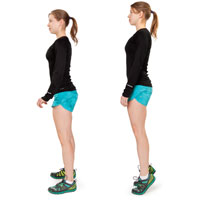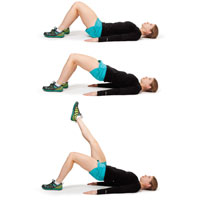
Pain takes the fun out of almost any activity, including running. Prehab exercises help prevent common running injuries before you hit the road, track, or trail.
Ask yourself if you’ve ever had pain while out for a run, or afterward, and you’ll likely say yes. It might be your knee, hip, or back, or just general aches and pains. Nothing specific happened that you can recall; it just hurts now and then, or when you run.
Pain zaps enjoyment
“Running needs to be rewarding,” says elite running coach Jack Daniels in his new book, Daniels’ Running Formula, Third Edition (Human Kinetics, 2013). As a runner, you know that pain equals less enjoyment on the track—it will no longer be a rewarding activity when you’re experiencing discomfort. You may even have to hang up your running shoes while you rest and recover from your aches and pains if they persist.
If you’ve had an injury in the past that required time off from running to rehabilitate a muscle, tendon, ligament, or joint injury; you were probably on the couch and off the trail for a period of time.
Common running injuries
Running is amazing exercise and a terrific stress reliever, but it can also cause a slew of injuries, from joint sprains and back pain to plantar fasciitis. Here is a list of some common running maladies that can be directly caused by running, or can become worse when you run.
Runner’s knee
A common problem for runners that can happen as a result of overuse, the cartilage under the kneecap can become damaged, causing dull, aching pain in the front of the knee especially when walking up or down stairs, kneeling, or squatting.
Iliotibial (IT) band syndrome
The IT band is a ligament that runs down the outside of the thigh from the top of the hip to the outside of the knee. When the IT band is overdeveloped and tight, there may be rubbing against the outer part of the knee or hip, causing pain.
Piriformis syndrome
This is a neuromuscular condition characterized by hip and buttock pain. In this condition, the piriformis, a small muscle that sits under the glutes and externally rotates the leg, becomes very tight and can cause the sciatic nerve to become irritated.
Shin splints
Characterized by pain just behind the shinbone, or tibia—the large bone in the front of the lower leg—shin splints can occur following a sudden change in intensity or distance and are thought to be a result of too much stress on the shinbone and the connective tissues between muscles and bone.
Achilles tendonitis
The Achilles tendon connects calf muscles to the heel bone and can be strained following repetitive stress or a sudden increase in intensity. Pain begins as a mild ache above the heel or back of the leg.
Plantar fasciitis
A thick tendon running along the bottom of the foot from heel bone to toes can become inflamed in runners, especially those with tight calf muscles or a high arch. Pain can feel like stabbing in the heel and is often worse first thing in the morning.
Why we should prehab
While taking time to rehabilitate may be a common experience for seasoned runners, it doesn’t have to be. With the right amount of preventive care—what’s called “prehab”—you can lace up with more confidence.
Although it may seem boring and less worthwhile to do exercises that don’t directly increase your speed or heart rate, it’s much better to do preventive maintenance (like a car getting its oil changed) to avoid injury down the road from improperly maintained muscles and joints.
“You don’t want to have to come to me and jeopardize accomplishing your running and fitness goals,” says Martin Chisholm, PT, FCAMPT, a physiotherapist in London, Ontario, who is a frequent speaker on the subject of running injuries.
“With running injuries being multifactorial, one generic exercise routine (or any isolated intervention) is unlikely to prevent injury …
“Since no study has looked at the best way to prevent running injuries, we then design programs based on common deficits we see in individuals who do get injured. This is combined with sound advice about progressing the intensity of the running program, use of proper running form, proper footwear, and nutrition,” says Chisholm.
The following are five physiotherapist-approved exercises to prehab your body for running. These can be done indoors, outdoors, at home, or at the gym.
Side Steps with Band

Standing tall with a resistance band around your ankles, put your hands on your hips and take a big step to the side, lifting your foot off the floor about an inch.
- Step down and follow through with your other foot.
- Continue side stepping in one direction, then change to the other lead leg.
- Increase the tension by changing band colour.
Joints targeted: sacroiliac and hip
Sets and repetitions: 2 sets of 10 in each direction
Calf Raises

Stand on the floor with your feet hip-width apart. You can hang onto a wall for balance.
- Stand up on your toes, pushing up with your calves. Hold for 1 to 2 seconds, then repeat.
- For a more difficult progression, stand on an elevated step and hang your heels over the edge.
Joints targeted: ankle
Set and repetitions: 2 sets of 10
Romanian Dead Lifts or Good Mornings

Stand with your feet on the floor, hip-width apart, and hold onto a dowel or two light weights (3 to 5 lbs each).
- With legs slightly bent, lean forward from your hips, keeping your back straight. Your arms should hang down in front of you.
- Slowly pull yourself back up, engaging your core without bending your back.
- Progress to a one-legged dead lift for increased difficulty.
Joints targeted: sacroiliac, hip, and knee
Set and repetitions: 2 sets of 10
Bridging

Lying on your back with your feet flat on the floor and hip-width apart, push your bum up off the floor and squeeze your butt cheeks, maintaining a straight line from knees to shoulders.
- Hold for 20 to 30 seconds.
- Slowly lower yourself down.
- Progress to one leg for increased difficulty.
Note: Chisholm suggests incorporating a pelvic tilt into this exercise to isolate the gluteals and help stretch the hip flexors.
Joints targeted: sacroiliac and hip
Set and repetitions: 2 sets of 10
Walking on Heels

Stand up tall with your arms by your sides.
- Take a step forward with one heel, then follow through with the other, keeping your toes lifted.
- Continue walking on your heels.
Joints targeted: ankle
Set and repetitions: 2 sets of 10 steps on each foot
What about stretching?
The question of stretching before running has become more and more confusing, with conflicting messages suggesting that we should only stretch before, only stretch after, or not to do static stretching at all. So what should you be doing?
Chisholm says, “The general research is that stretching, in and of itself, does not prevent injury in athletics. Currently, we favour a more dynamic approach to warming up. Running itself can be an excellent dynamic warm-up if you start off nice and slow for the first part of your run.”
Chisholm does endorse some post-run stretches such as those that follow. Stretches should be held for 20 to 30 seconds each, and can be repeated as needed.
quads stretch—standing up, bring heel to bum
- hamstring stretch—place foot on a step, lean forward
- kneeling lunge stretch for hip flexors—lunge forward with one knee on mat
- IT band stretch—side bend with arm reaching overhead and with one leg crossed over the other at the ankle
- piriformis stretch—pigeon pose from yoga: lunge stretch with front leg bent at the knee; lean over leg
Prehab or rehab?
As a personal trainer I see many clients who have injured themselves by overdoing it or from some random move when something snapped or popped out of the blue.
When we don’t maintain our bodies by cross-training, stretching, and strengthening, it’s easy for things to get weaker, tighter, or even looser depending on what is off-kilter. Running alone is not enough to stay healthy and strong; we need to take care of the total package.
A good prehab routine will help prevent these issues. If you keep your body in balance and alignment through proper training and nutrition, you should be able to continue enjoying your trails and races without injury.
Fighting inflammation
Inflammation occurs when there is trauma. It’s a response to cellular injury that can cause heat, pain, and redness locally (think of a pulled muscle or sprained joint).
Current research shows that following the Mediterranean diet can help reduce inflammation and promote overall wellness.
Foods
- plenty of fruits and vegetables
- whole grains
- healthy fats such as extra-virgin olive oil
- legumes, nuts, and seeds
- red wine
- fish and lean meats such as poultry
- herbs and spices instead of salt
Supplements
- vitamins A, B6, C, D3, and E
- fish oil
- curcumin (turmeric)
- green tea
- Pycnogenol
- Boswellia serrata (frankincense)
- resveratrol
- Uncaria tomentosa (cat’s claw)
- capsaicin (chili pepper)
- selenium




































